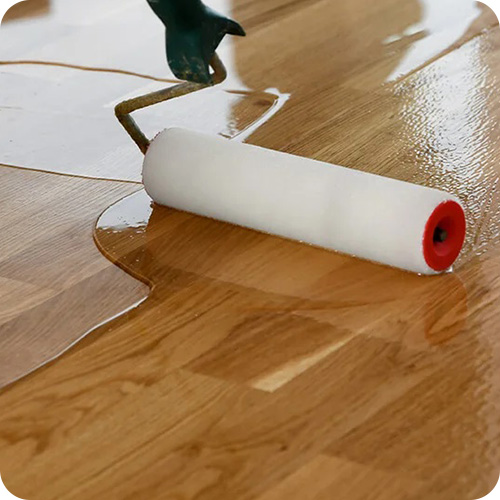SPC Flooring Maintenance: Full Guide
Nov 13, 2025, 7:30 AM
SPC Flooring (Stone Plastic Composite) is a popular choice for residential and commercial spaces due to its durability, waterproof properties, and ease of installation. Proper maintenance of SPC flooring can extend its lifespan, preserve its appearance, and keep it in optimal condition. Here's a comprehensive guide to maintaining SPC Flooring, covering daily care, cleaning, protection, and damage prevention.
1. Daily Care and Cleaning: To maintain the beauty and functionality of SPC flooring, regular cleaning is essential. This involves simple, everyday tasks that prevent dirt, dust, and debris from accumulating.
- Sweeping and Vacuuming: Use a soft-bristle broom or a vacuum cleaner designed for hard surfaces. Avoid using vacuums with beater bars or hard bristles that could scratch the floor.
- Damp Mopping: For daily mopping, use a damp microfiber mop. SPC flooring is waterproof, but excessive moisture can affect the subfloor or edges. Never soak the floor; ensure the mop is well-wrung out.
- Mild Cleaning Solutions: Use a pH-balanced cleaner or a solution of warm water and mild soap. Harsh chemicals or abrasive cleaners can degrade the surface coating of SPC flooring.
Tip: Clean spills immediately to avoid staining or potential damage to the seams. SPC flooring is resistant to water, but liquids left standing for extended periods can penetrate edges or underlayment.
2. Periodic Deep Cleaning: In addition to routine cleaning, periodic deep cleaning helps maintain the floor's luster and removes stubborn dirt.
- Steam Cleaning: Avoid steam cleaning. While SPC flooring is waterproof, high heat and moisture can compromise the adhesive or cause the floor to warp over time.
- Non-Abrasive Scrubbing: For tougher stains or dirt buildup, use a soft sponge or non-abrasive scrubbing pad. Always test cleaning solutions on a small, inconspicuous area before applying them broadly.
Frequency: Deep cleaning should be done every 1-2 months, depending on foot traffic and usage.

3. Preventing Damage: Although SPC flooring is designed to be durable, taking precautionary steps to prevent damage is critical to maintaining its appearance.
- Use Furniture Pads: Attach felt pads to the legs of chairs, tables, and other furniture to prevent scratches when moving them.
- Place Rugs and Mats: Use entryway rugs or mats at doors to catch dirt, sand, and moisture before it reaches the flooring. Opt for non-rubber-backed mats to avoid discoloration of the SPC floor.
- Protect from Sharp Objects: Keep pets’ nails trimmed and avoid dragging heavy items across the floor, as these can cause scratches or gouges.
4. Handling Stains and Spills: Though SPC flooring is stain-resistant, certain substances can leave marks if not handled properly.
- Water-based Spills: Wipe up water, juice, or coffee spills immediately with a soft, dry cloth.
- Oily or Greasy Substances: For oil or grease-based stains (e.g., food spills), use a mild detergent mixed with warm water to clean the area.
- Ink or Marker: Use a soft cloth dampened with rubbing alcohol to gently remove ink or permanent marker stains. Avoid harsh scrubbing that can damage the protective surface layer.
Tip: For deep stains or scuffs, avoid abrasive chemicals like acetone. These may cause discoloration or damage to the wear layer.
5. Temperature and Humidity Control: SPC flooring is less susceptible to temperature fluctuations compared to wood flooring, but it's still important to maintain a stable environment to avoid minor expansion or contraction.
- Ideal Temperature: Keep room temperatures between 60°F and 85°F (15°C - 29°C) for optimal performance.
- Humidity Levels: Maintain indoor humidity levels between 30% and 50% to prevent excessive contraction or expansion of the flooring. Use a humidifier or dehumidifier if necessary.
6. Restoration and Repair: Over time, wear and tear might result in scratches, dents, or loss of shine on your SPC flooring. Fortunately, restoration methods can address these issues.
- Scratch Repair: For minor surface scratches, use a touch-up kit designed for SPC or vinyl flooring. These kits often include wax sticks or markers that can blend into the floor's finish.
- Replacing Damaged Planks: SPC flooring uses a click-lock installation system, which makes it relatively easy to replace damaged planks without disrupting the entire floor. Remove and replace the affected section.
Tip: Always keep spare planks after installation for potential repairs.
7. Do’s and Don’ts of SPC Flooring Maintenance: To summarize, here’s a quick list of essential do’s and don’ts when it comes to SPC flooring maintenance.

Do’s
- Sweep or vacuum daily to remove dirt and debris.
- Use a damp microfiber mop for cleaning.
- Wipe up spills immediately to prevent staining.
- Use felt pads under furniture and place mats in high-traffic areas.
- Control room humidity and temperature.
Don’ts
- Avoid steam cleaning or soaking the floor.
- Do not use abrasive cleaning tools or harsh chemicals.
- Avoid dragging heavy furniture or sharp objects across the floor.
- Never use wax or varnish on SPC flooring, as these products can create a slippery surface.
SPC flooring is low-maintenance compared to traditional hardwood or laminate floors, but proper care is still essential to prolong its life and maintain its appearance. Following a regular cleaning schedule, protecting the floor from potential damage, and promptly addressing stains or spills will ensure your SPC flooring remains in top condition for years to come.


 皖公网安备 34180202000049号
皖公网安备 34180202000049号